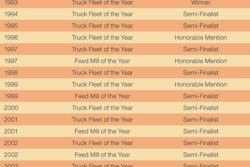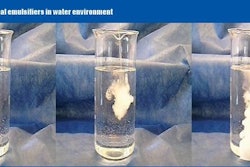The feed industry took a historic step during this year's International Poultry Exposition and International Feed Exposion with the formation of a Latin American feed industry association Feed Latina.
Meeting on the penultimate day of the co-located shows, more than 30 Latin American feed representatives gathered in the Georgia Congress Centre to approve the formation of the new association, agree to its constitution, adopt a structure, appoint its president and vice-presidents, and wish it well for the future.
Based in Brazil in the offices of the Brazilian Feed Industry Association, Sindiracoes, in San Paolo the new association will encompass the entire Latin American continent and the Caribbean.
Sindiracoes' president Mario Sergio Cutait has been elected president of Feed Latina with Antonio Pedroza of the Animal Nutrition and Feed Industry Council of Mexico (CONAFAB) being elected its vice president for the Mexican and Caribbean region. Dr Fernando Eluchans of the Chamber of Animal Nutrition Industry Argentina (CAENA) was elected vice president for the South American region and Dr Ariovaldo Zanni, Sindiracoes' CEO, was appointed Feed Latina's first director-treasurer.
Building a strategic plan
The key objective of Feed Latina is to develop a strategic plan, based on proper structure for the feed sector in the region, says Dr Zanni. "That focus will be on sustainability of animal protein production. One of our first actions will be to develop a professional and scientific base for the region that will include a communication network that will allow us to address different technical and regulatory demands facing our region.
"This new association will help us foster trade between countries within the region and will also promote trade between our region's economic blocs."
Dr Zanni says that forming a regional feed association will strengthen the Latin American industry's image in the eyes of the International Feed Industry Federation (IFIF) and other international bodies such as the United Nation's Food and Agriculture Organisation (FAO), World Trade Organisation (WTO) and World Health Organisation (WHO).
Built over time
IFIF president Fred Stephens says the seeds of the new association were planted more than four years ago and that IFIF can be proud of its role in being instrumental in bringing together the existing associations in the region to consider the benefits of working closer together.
"By hosting two world feed congresses in Brazil, we were able to lay a foundation for feed interests throughout the region to come together."
It also allowed the FAO to support the efforts of the region's feed associations in organising themselves into a formal body, he adds.
Sindiracoes' president Mario Sergio Cutait underscores that communication will be key to the success of the association. He says that by forming Feed Latina, Latin American feed interests have a platform on which to gather to discuss common issues. However, it will be communications that will determine the future success of the association. Communications within the region, and between member associations and companies, will provide an avenue to discuss pertinent issues that effect all multinational associations. Stephens points out that a very good example of this working effectively is the European Feed Manufacturers Federation (FEFAC), representing almost all European Union member state feed associations.
In today's changing world, and in particular with reference to feed safety and trade, meeting regulatory standards within a region and sharing information about issues as they pertain to exports from that region to the international community is vital, adds Mr Cutait. Communication will provide the opportunity to address trade issues from within, allowing for the community of Latin countries to discuss tariffs that hamper trade with each other.
Meanwhile, the FAO projects that 65 percent of the anticipated increase of 100,000,000 tonnes of meat protein in the coming years will be produced in developing nations. This trend suggests Latin America and Mexico will have increasing influence and participation on the global stage.
"As I have previously stated, by forming an association the region will have greater influence and my analogy is that by making the fingers of a hand into a fist you can create more power and strength. Communicating with the world, by speaking with one voice rather then 10, will provide power and strength to the feed sector," says Mr Stephens.
Organisers of the new association say that internal communication will also provide a bridge between safe feed and safe food. "It will bring consistency and confidence knowing that your neighbour will be addressing feed safety, traceability and ingredient safety in the same manner as yourself," explains Mr Cutait. Adding to the benefits of internal communication and collaboration will be the region's magnified influence due to its ability to speak with one voice.
Filling a void
The development of Feed Latina will also mean that other feed groups such as FEFAC, AFIA and the CFIA, along with the major corporate suppliers, will be able to reach the region via one association rather than the arduous task of travelling and communicating with each country separately. "Today, there is no structure that represents Latin America and Mexico. Feed Latina will fill that void," Mr Stephens adds.
The new leaders of Feed Latina say they believe the implications that flow from the formation of the new organization will only be restrained by imagination. The single most important objective will be promoting acceptance of the concept that the success of the region is perhaps more important then that of any one member as the group moves forward, they say. Spokespersons for the group sum up that the hope is that improved communication will dramatically increase the sharing of technology and provide a source of information and training opportunities far beyond that perceived at present.
.jpg?auto=format%2Ccompress&fit=crop&h=167&q=70&w=250)














